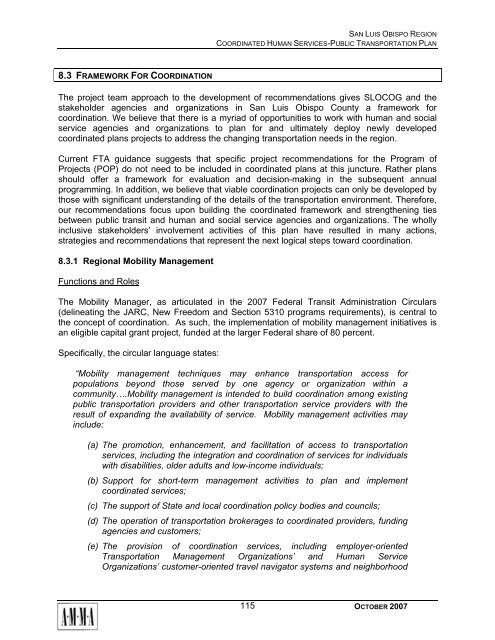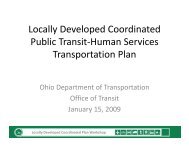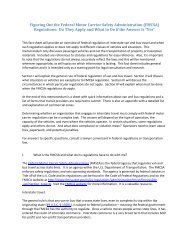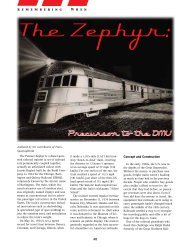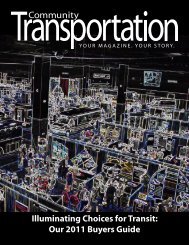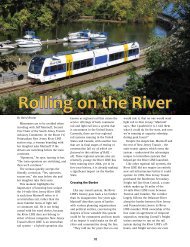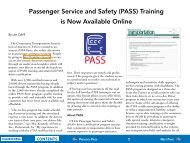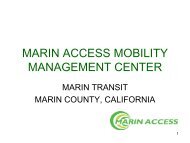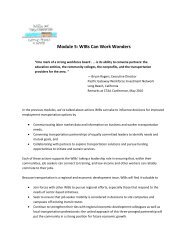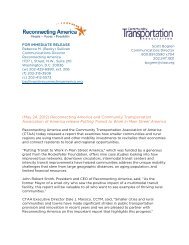San Luis Obispo - Caltrans - State of California
San Luis Obispo - Caltrans - State of California
San Luis Obispo - Caltrans - State of California
Create successful ePaper yourself
Turn your PDF publications into a flip-book with our unique Google optimized e-Paper software.
SAN LUIS OBISPO REGION<br />
COORDINATED HUMAN SERVICES-PUBLIC TRANSPORTATION PLAN<br />
8.3 FRAMEWORK FOR COORDINATION<br />
The project team approach to the development <strong>of</strong> recommendations gives SLOCOG and the<br />
stakeholder agencies and organizations in <strong>San</strong> <strong>Luis</strong> <strong>Obispo</strong> County a framework for<br />
coordination. We believe that there is a myriad <strong>of</strong> opportunities to work with human and social<br />
service agencies and organizations to plan for and ultimately deploy newly developed<br />
coordinated plans projects to address the changing transportation needs in the region.<br />
Current FTA guidance suggests that specific project recommendations for the Program <strong>of</strong><br />
Projects (POP) do not need to be included in coordinated plans at this juncture. Rather plans<br />
should <strong>of</strong>fer a framework for evaluation and decision-making in the subsequent annual<br />
programming. In addition, we believe that viable coordination projects can only be developed by<br />
those with significant understanding <strong>of</strong> the details <strong>of</strong> the transportation environment. Therefore,<br />
our recommendations focus upon building the coordinated framework and strengthening ties<br />
between public transit and human and social service agencies and organizations. The wholly<br />
inclusive stakeholders’ involvement activities <strong>of</strong> this plan have resulted in many actions,<br />
strategies and recommendations that represent the next logical steps toward coordination.<br />
8.3.1 Regional Mobility Management<br />
Functions and Roles<br />
The Mobility Manager, as articulated in the 2007 Federal Transit Administration Circulars<br />
(delineating the JARC, New Freedom and Section 5310 programs requirements), is central to<br />
the concept <strong>of</strong> coordination. As such, the implementation <strong>of</strong> mobility management initiatives is<br />
an eligible capital grant project, funded at the larger Federal share <strong>of</strong> 80 percent.<br />
Specifically, the circular language states:<br />
“Mobility management techniques may enhance transportation access for<br />
populations beyond those served by one agency or organization within a<br />
community….Mobility management is intended to build coordination among existing<br />
public transportation providers and other transportation service providers with the<br />
result <strong>of</strong> expanding the availability <strong>of</strong> service. Mobility management activities may<br />
include:<br />
(a) The promotion, enhancement, and facilitation <strong>of</strong> access to transportation<br />
services, including the integration and coordination <strong>of</strong> services for individuals<br />
with disabilities, older adults and low-income individuals;<br />
(b) Support for short-term management activities to plan and implement<br />
coordinated services;<br />
(c) The support <strong>of</strong> <strong>State</strong> and local coordination policy bodies and councils;<br />
(d) The operation <strong>of</strong> transportation brokerages to coordinated providers, funding<br />
agencies and customers;<br />
(e) The provision <strong>of</strong> coordination services, including employer-oriented<br />
Transportation Management Organizations’ and Human Service<br />
Organizations’ customer-oriented travel navigator systems and neighborhood<br />
115<br />
OCTOBER 2007


